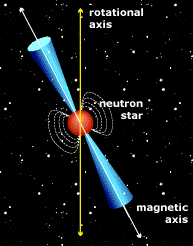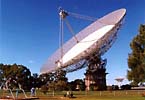What Exactly Are Pulsars?
![]() Pulsars are stars that are exceptionally small and quite dense. 260 million pulsars could fit into 1 earth, and 1.3 million earths would fit into our sun. Though a small fraction of the earth's size, pulsars can have a gravitational field that is 1 billion times stronger than that of earth. Astronomers believe that these neutron stars are the remnants of collapsing stars, or supernovae. As a dying star loses energy, it begins to collapse. As it collapses, all its matter is squashed together, becoming more and more dense. As more of the star's matter moves toward its center, the star spins faster and faster, in much the same way that figure skaters spin faster as they pull their arms inward. This explains the incredibly rapid rotation of certain pulsars.
Pulsars are stars that are exceptionally small and quite dense. 260 million pulsars could fit into 1 earth, and 1.3 million earths would fit into our sun. Though a small fraction of the earth's size, pulsars can have a gravitational field that is 1 billion times stronger than that of earth. Astronomers believe that these neutron stars are the remnants of collapsing stars, or supernovae. As a dying star loses energy, it begins to collapse. As it collapses, all its matter is squashed together, becoming more and more dense. As more of the star's matter moves toward its center, the star spins faster and faster, in much the same way that figure skaters spin faster as they pull their arms inward. This explains the incredibly rapid rotation of certain pulsars.
 (c) 1996 STSCI Galaxies sprinkle the sky in this image obtained by the Hubble Space Telescope. The area of sky in this image could be covered by a dime held 75 feet away. |
Why do pulsars "pulse"?
Pulsars do not actually turn on and off. They emit a constant stream of energy. This energy is focused into a stream of electromagnetic particles that are ejected from the star's magnetic poles at the speed of light. The magnetic axis of the neutron star is at an angle to the rotational axis, just as magnetic north and true north are slightly different on the earth. As the star spins, this beam of energy sweeps through space like the beam of a lighthouse or an ambulance light. Only when this beam shines directly on the earth are we able to detect the pulsar with radio telescopes.
Even though pulsars emit light in the visible spectrum, they are far too small and far away for us to detect any of this visible light. We are only able to use radio telescopes to detect the strong high-frequency radio energy they emit.
What can we hope to learn by continuing to search for and study pulsars?
Because pulsars are found in the debris of collapsed supernovae, they can help us understand what happens when stars collapse. They can also offer insights into the birth and evolution of the universe. Plus, there are many ways in which the behavior of pulsars can change over time.
For one thing, the period of each pulsar is not exactly constant. It is the rotational energy of the neutron star which is the source for the electromagnetic radiation that we can detect. As the pulsar emits this electromagnetic radiation, it loses some of its rotational energy and slows down. By measuring their periods of rotation month after month and year after year we can deduce exactly how much they slow down, how much energy they lose in the process and even how long they should live until they spin so slowly that they are not able to shine.
 It also turns out that each pulsar is unique in its own way. Some are exceedingly bright, some have starquakes that momentarily spin them up, some have companion stars in binary orbits, and a few dozen of them spin extraordinarily fast, up to a thousand times per second. Each new discovery brings new and unique data that scientists can use to help us understand the universe
It also turns out that each pulsar is unique in its own way. Some are exceedingly bright, some have starquakes that momentarily spin them up, some have companion stars in binary orbits, and a few dozen of them spin extraordinarily fast, up to a thousand times per second. Each new discovery brings new and unique data that scientists can use to help us understand the universe
This content has been re-published with permission from SEED. Copyright © 2025 Schlumberger Excellence in Education Development (SEED), Inc.

